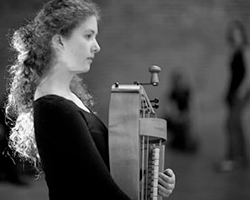by Nicholas Jones

The centerpiece of the program was a substantial cantata titled L’Hyver (Winter), one of a cycle of four cantatas on the seasons by the early-18th-century composer Joseph Bodin de Boismortier. With appropriate Baroque word-painting, Boismortier depicts winter’s horrors—bare trees, mountain storms, and frost-stricken buds—then shifts to winter’s pleasures—dances, feasts, and plays. Winter’s destructive fury turns out to be a foil to the delights of a Parisian salon, well heated and well stocked with wine and music.
The presiding muse of those delights was the masterful soprano Clara Rottsolk, who was featured on Les Délices’ recent CD, Myths and Allegories. Much of the pleasure lay in Ms. Rottsolk’s sophisticated mastery of the nuances of the libretto: with perfect diction and expressive delivery, she took the horrors and delights of this French “winter” seriously, and at the same time, with a raised eyebrow, enabled us to see these supposed terrors as delicately aestheticized constructions of an urbane and privileged society.
Another delight was the instrumental playing in the Boismortier: precise, supportive, and far from wintry. The musicians, along with Ms. Nagy, were first-rate players who have become regulars with Les Délices—gambist Emily Walhout, harpsichordist Michael Sponseller, and violinists Scott Metcalfe and Julie Andrijeski. Particularly moving was a trio, without continuo, of soprano, oboe, and violin (Ms. Andrijeski), a minuet in which the enforced leisure of winter is shown to equal the pleasures of the other more temperate seasons: the languid interplay of these three equal parts had the nuanced and satiny glimmer of a Boucher pastoral.

I had not known much about the hurdy gurdy, but from the program notes and some digging on the internet, I learned that it had originally been a medieval instrument. During the Renaissance, it was mostly seen in the hands of street musicians and dance bands. But in the 18th-century French court, where the “simple life” was the model for courtiers such as the shepherdess queen Marie Antoinette, the hurdy gurdy underwent a strange rebirth and began to feature as a solo instrument in chamber ensembles.
To match this craze, composers began to write for the instrument, among them one Nicholas Chedeville, who adapted Vivaldi’s Four Seasons. We heard two of these concertos (“Spring” and “Fall”), as well as a duo for violin and oboe by Charles Buterne, also here adapted for the hurdy gurdy.
The playing was virtuosic: Tobie Miller is fleet of finger, as the solo violin parts in Vivaldi demand. Her “bow hand,” too—the right hand that cranks the bowing wheel—captures a good deal of expression and variety. Especially successful was the famous s from “Autumn,” where, with pizzicato string accompaniment signifying the raindrops falling from the eaves, the solo hurdy gurdy sounded appropriately melancholic and poetic.
It was strange to hear the familiar Vivaldi concertos repackaged for this instrument. The presence of continuous drones meant that any but the simplest modulations were out of the question. Even when the music led merely to the dominant, the tonic drone gave a curious edge to the chord.
Moreover, though Ms. Miller “bows” with considerable skill, the instrument basically produces a continuous sound, both on the drone and on the “chanter” (the melody string). As a result, the flamboyant violin writing of the Italian Baroque is drastically reduced in variety of tone, timbres, and articulation.
But the point, of course, was not to present “original” Vivaldi. I came away from Ms. Miller’s performances with a much-broadened sense of the kinds of sounds that the French baroque appreciated. While we often think of this age as ultra-refined, it is clear that they cared about more than refinement: the hurdy gurdy was something like the accordion of the day (no accordion jokes needed here), and yet the courtiers and bourgeoisie of Paris welcomed it into their chamber music. The instrument’s assertive earthiness might have something to teach us about performing other music of the period.
I heard the program Saturday night at the William Busta Gallery downtown, where the performers enjoyed the intimate space amid colorful geometrical acrylics by northeast Ohio artist Douglas Sanderson. The program was repeated Sunday afternoon at Plymouth Church in Shaker Heights.
Nicholas Jones is Professor of English at Oberlin College and a keen amateur musician.
Published on ClevelandClassical.com April 22, 2013
Click here for a printable version of this article.



